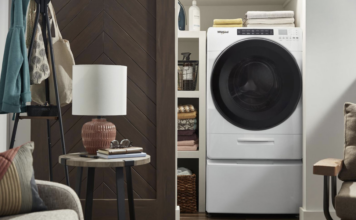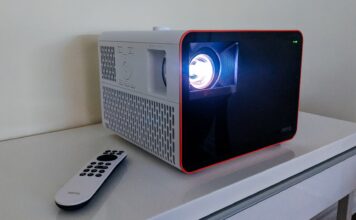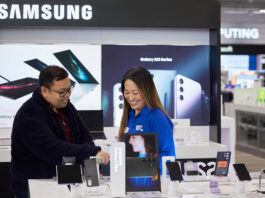 Why don’t more people mount their slim 4K TVs to the wall? Often this mounting system is cleaner, easier to use, frees up valuable space, and looks professional. The answer is because many folks don’t know how easy it can be to create that professional look, with unsightly cords and cables hidden out of the way. There are a few ways to do it; take a look at some of these ideas.
Why don’t more people mount their slim 4K TVs to the wall? Often this mounting system is cleaner, easier to use, frees up valuable space, and looks professional. The answer is because many folks don’t know how easy it can be to create that professional look, with unsightly cords and cables hidden out of the way. There are a few ways to do it; take a look at some of these ideas.
Cable management: Hide cables inside the wall
You may think you need a professional to run conduit inside your wall so you can hide power cords and cable TV lines, and while hiring a pro, like Geek Squad, is always a good idea if you’re not handy, it is possible to do this yourself with some simple tools and a bit of planning.
The SANUS ELM806-W3 is an in-wall cable management system that eliminates wires and cables from hanging below your wall-mounted TV. It’s a quick and easy way to create a professional look for your home theatre.
In essence, you cut a small opening in the drywall behind your TV, and another at the bottom near a plug, then run the cables through the inside of the wall. Covers conceal the drywall cuts and provide a tidy, professional look.
You’ll want to look for cables that are in-wall rated if you’re going this route. The wrong cable in the wrong place can lead to significant safety hazards. HDMI cables can make a long run down and inside the wall.
Cable management: Choose the right HDMI cable
You know you need a quality HDMI cable to connect your TV to key components. To keep messy cables to a minimum, make sure you wrap up any excess cable to prevent it from falling down the wall.
For starters, try to buy an HDMI cable only as long as you need for your particular set up. If you’re connecting an Apple TV, consider getting a shorter HDMI cord, then using velcro to attach the Apple TV to the back of your television (with just the edge peeking out to see the infrared remote), and using velcro cable wraps to coil up any excess.
Velcro and plastic cable ties can go a long way to keep drooping cords and loops of extra cables from slipping out from behind your TV and ruining the bezel-less, minimal aesthetic.
Cable management: The power of Power Bars
If you have multiple components to plug in but limited power outlets, a power bar can be your best friend.
It’s always a good idea to get a power bar with surge protection so you never need to worry about damaging your electronics in the event of a power surge.
You can find them in a variety of configurations, some with only a few outlets and others with many like this 7-outlet Rocketfish power bar with surge protection that will keep your electronics safe.
This Monster wall mounted 6-outlet surge protector is also pretty handy and keeps things off the floor and looking tidy.
Cable management: Try cable clips and tracks
If you don’t want to opt for an in-wall cable management system (maybe you’re renting and that’s not allowed) you can still manage your cables and get a clean look for your home theatre.
You can find a variety of clips and cord covers that will camouflage all the different home theatre component cords. This Wiremold version is simple to install and masks the worst of the clutter with a clean cover. The cover itself can be painted, so you can get the perfect masking effect for any room.
You don’t need to stare at ugly wires or let them distract from your fabulous 4K, HDR video. Take a look at all the options for cable management from Best Buy.








































Each cable comes in a 2 conductor or a 3 conductor with an optional ground wire. The ground wire is never stranded and usually smaller in size than the conductors. The most popular is the Romex 6/3 because it covers the average electrical supply amount to an appliance or hot tub.
Comments are closed.